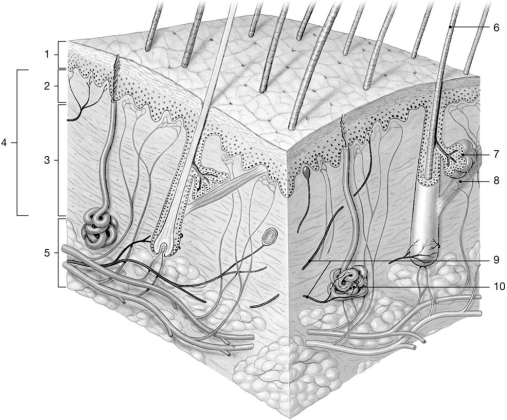A) eponychium.
B) hyponychium.
C) free edge.
D) perinychium.
E) lunula.
G) A) and C)
Correct Answer

verified
Correct Answer
verified
Multiple Choice
Which of the following happens if body temperature rises above normal?
A) Circulation in the skin decreases.
B) Sweat gland activity decreases.
C) Evaporative cooling stops.
D) Blood flow to the skin increases.
E) The activity of melanocytes increases.
G) A) and E)
Correct Answer

verified
Correct Answer
verified
Multiple Choice
________ are cells in the epidermis that are part of the immune system.
A) Dendritic cells
B) Basal cells
C) Merkel cells
D) Squamous cells
E) Melanocytes
G) B) and C)
Correct Answer

verified
Correct Answer
verified
Multiple Choice
The combination of blood clot,fibroblasts,and extensive capillary network that is formed in injured skin is called ________ tissue.
A) germinative
B) spinous
C) fibrocytic
D) granulation
E) abscess
G) A) and E)
Correct Answer

verified
Correct Answer
verified
Multiple Choice
 Figure 5-1 The Components of the Integumentary System
Use Figure 5-1 to answer the following questions:
-Adipose tissue is a major component of the region labeled
Figure 5-1 The Components of the Integumentary System
Use Figure 5-1 to answer the following questions:
-Adipose tissue is a major component of the region labeled
A) 1)
B) 2)
C) 3)
D) 4)
E) 5)
G) C) and D)
Correct Answer

verified
Correct Answer
verified
Multiple Choice
The layer of hard keratin that coats the hair is termed the
A) medulla.
B) cuticle.
C) hair bulb.
D) root.
E) shaft.
G) A) and E)
Correct Answer

verified
Correct Answer
verified
Multiple Choice
Large quantities of keratin are found in the epidermal layer called the stratum
A) corneum.
B) lucidum.
C) basale.
D) granulosum.
E) spinosum.
G) A) and E)
Correct Answer

verified
Correct Answer
verified
Multiple Choice
The two components of the integumentary system are the
A) epidermis and dermis.
B) cutaneous membrane and hypodermis.
C) cutaneous membrane and accessory structures.
D) integument and hypodermis.
E) epidermis and superficial fascia.
G) B) and C)
Correct Answer

verified
Correct Answer
verified
Multiple Choice
The nail body covers the
A) nail root.
B) nail bed.
C) lunula.
D) free edge.
E) hyponychium.
G) C) and D)
Correct Answer

verified
Correct Answer
verified
Multiple Choice
All of the following are true of the subcutaneous layer except it
A) contains many blood vessels.
B) permits independent movement of deeper structures.
C) contains large amounts of adipose tissue.
D) is attached to the dermis by a basement membrane.
E) is well supplied with nerves that pass into the skin.
G) None of the above
Correct Answer

verified
Correct Answer
verified
Multiple Choice
 Figure 5-1 The Components of the Integumentary System
Use Figure 5-1 to answer the following questions:
-Which layer contains most of the accessory structures?
Figure 5-1 The Components of the Integumentary System
Use Figure 5-1 to answer the following questions:
-Which layer contains most of the accessory structures?
A) 1
B) 2
C) 3
D) 4
E) 5
G) None of the above
Correct Answer

verified
Correct Answer
verified
Multiple Choice
Four signs useful for determining if a suspicious mark on the skin is melanoma follow the ABCD mnemonic.Which pairing is incorrect?
A) A - asymmetry
B) B - border
C) C - circumference
D) D - diameter
E) They are all correct
G) A) and C)
Correct Answer

verified
Correct Answer
verified
Multiple Choice
 Figure 5-1 The Components of the Integumentary System
Use Figure 5-1 to answer the following questions:
-Which tissue is located in the region labeled "2"?
Figure 5-1 The Components of the Integumentary System
Use Figure 5-1 to answer the following questions:
-Which tissue is located in the region labeled "2"?
A) stratified squamous epithelium
B) areolar connective tissue
C) adipose tissue
D) cartilage and blood
E) reticular connective tissues
G) A) and B)
Correct Answer

verified
Correct Answer
verified
Multiple Choice
The effects of aging on the skin include
A) a decline in the activity of sebaceous glands.
B) increased production of vitamin D.
C) thickening of the epidermis.
D) an increased blood supply to the dermis.
E) a decreased number of sweat glands.
G) All of the above
Correct Answer

verified
Correct Answer
verified
Multiple Choice
The layer of the skin that contains the blood vessels and nerves that are closest to the surface of the skin is the ________ layer.
A) papillary
B) reticular
C) epidermal
D) subcutaneous
E) hypodermal
G) B) and E)
Correct Answer

verified
Correct Answer
verified
Multiple Choice
Glands that discharge an oily secretion into hair follicles are ________ glands.
A) ceruminous
B) apocrine sweat
C) merocrine sweat
D) sebaceous
E) mammary
G) A) and E)
Correct Answer

verified
Correct Answer
verified
Multiple Choice
Types of skin cancers include
A) squamous cell carcinoma.
B) malignant melanoma.
C) basal cell carcinoma.
D) actinic keratosis.
E) A,B,and C
G) None of the above
Correct Answer

verified
Correct Answer
verified
Multiple Choice
Fine hairs (like "velvet") that lack pigment and cover much of the body surface are called ________ hairs.
A) veneer
B) gossamer
C) lanugo
D) vellus
E) terminal
G) A) and E)
Correct Answer

verified
Correct Answer
verified
Multiple Choice
 Figure 5-1 The Components of the Integumentary System
Use Figure 5-1 to answer the following questions:
-Which layer is the primary barrier against environmental hazards?
Figure 5-1 The Components of the Integumentary System
Use Figure 5-1 to answer the following questions:
-Which layer is the primary barrier against environmental hazards?
A) 1
B) 2
C) 3
D) 4
E) 5
G) A) and C)
Correct Answer

verified
Correct Answer
verified
Multiple Choice
Which of the following is not an effect of ultraviolet radiation?
A) increased activity by melanocytes
B) production of cholecalciferol within epidermal cells
C) reduced amounts of elastic fibers in the dermis
D) chromosomal damage in germinative cells or melanocytes
E) loss in skin pigmentation as seen in vitiligo
G) D) and E)
Correct Answer

verified
Correct Answer
verified
Showing 21 - 40 of 112
Related Exams